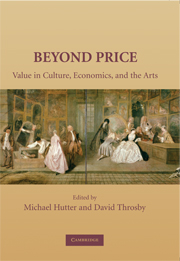Book contents
- Frontmatter
- Contents
- List of Contributors
- Preface
- 1 Value and Valuation in Art and Culture: Introduction and Overview
- PART ONE ORIGINS OF MEANING
- 2 Creating Value between Cultures: Contemporary Australian Aboriginal Art
- 3 Entertainment Value: Intrinsic, Instrumental, and Transactional
- 4 Creating Artistic from Economic Value: Changing Input Prices and New Art
- PART TWO THE CREATION OF VALUE IN ARTISTIC WORK
- PART THREE CONTINUITY AND INNOVATION
- PART FOUR APPRECIATION AND RANKING
- PART FIVE CULTURAL POLICIES
- Index
- Plate section
- Plate section
- References
4 - Creating Artistic from Economic Value: Changing Input Prices and New Art
from PART ONE - ORIGINS OF MEANING
- Frontmatter
- Contents
- List of Contributors
- Preface
- 1 Value and Valuation in Art and Culture: Introduction and Overview
- PART ONE ORIGINS OF MEANING
- 2 Creating Value between Cultures: Contemporary Australian Aboriginal Art
- 3 Entertainment Value: Intrinsic, Instrumental, and Transactional
- 4 Creating Artistic from Economic Value: Changing Input Prices and New Art
- PART TWO THE CREATION OF VALUE IN ARTISTIC WORK
- PART THREE CONTINUITY AND INNOVATION
- PART FOUR APPRECIATION AND RANKING
- PART FIVE CULTURAL POLICIES
- Index
- Plate section
- Plate section
- References
Summary
Introduction
The creation of sources of cultural newness is usually credited to the individuals who wrote, performed, or shaped the artworks. The newness is attributed to their rare “genius” – the painterly genius of Manet and Cézanne, of Pollock and Viola; the filmmaking genius of John Huston; or the musical genius of Jimi Hendrix. The relevance of the personal, mental, and physical contribution of artists is undisputed. This chapter tries to look beyond the personal contribution. Beyond the mental decision and its behavioral and material consequence, shifts in social circumstances take place, ranging from shifts in the immediate personal environment to shifts in the forces of society at large. These shifts change the constraints and the resources of those who are active in an artistic field. My focus will be on shifts in the availability of new resources and inputs, and on shifts in the relative prices of materials for artistic production.
At a first level, the argument uses a straightforward application of rational decision making: When the prices of goods that are relevant to artistic work change relative to the prices of other goods, the artists experience the change as a change in their financial constraints. Some options become affordable; others move out of reach. In either case, the artists, as well as those buying their works and performances, are faced with new choices.
Information
- Type
- Chapter
- Information
- Beyond PriceValue in Culture, Economics, and the Arts, pp. 60 - 72Publisher: Cambridge University PressPrint publication year: 2007
References
Accessibility standard: Unknown
Why this information is here
This section outlines the accessibility features of this content - including support for screen readers, full keyboard navigation and high-contrast display options. This may not be relevant for you.Accessibility Information
- 1
- Cited by
